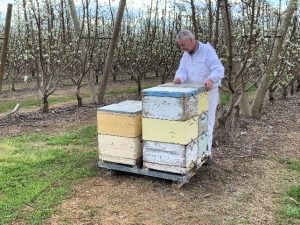Good crop yields start with effective pollination.
If you’re planning on bringing beehives into your orchard this pollination season, you should know beekeepers have already begun preparations to ensure that their bees will be in great health for pollination services. Below is a checklist you can discuss with your beekeeper (also known as an apiarist), to ensure healthy hives are supplied.

Preparation Checklist:
- Anyone who keeps one or more hives of bees in Victoria must register with Agriculture Victoria as a beekeeper. Their registered brand needs to be clearly marked on all their hives.
- Hives will be structurally sound, have intact external surfaces, and only have openings that are designed specifically for bee access.
- Beekeepers would have inspected the brood (baby bees) regularly, checking for pests and diseases before arrival. This means any diseased or substandard hives will have been removed before delivery.
- Beekeepers would have tested their hives for exotic parasites (such as Varroa mite) via drone uncapping and either the sugar shake or alcohol wash methods. Australia is the last major honey producing country in the world without the mite. We all want to keep it that way!
- Completion of an annual honey culture test, looking for the presence of American Foulbrood (AFB) in particular. AFB is very hard to detect in early stages. Beekeepers use this test as an ‘early warning’ of the presence of the disease. Ask your beekeeper if they have completed this annual test, if you can see a copy of the results and discuss it with them. If it is positive +1 result, they can still attend pollination but need to put actions in place to manage the weak/sick hives and ensure they only bring strong hives.
Note: This is mandatory for beekeepers who own 50 or more hives, but due to the increase biosecurity risk pollination brings, it’s highly recommended that anyone attending pollination, no matter how many hives complete a test. - Lastly, does your beekeeper communicate with you as the grower (or your agent/broker)? Do you receive information about their apiary? Have you discussed your expectations of hive numbers, placement, and strength? Does the beekeeper have any expectations from you?
While beekeepers are preparing their hives for your orchard, it is important that you provide an environment in and around the orchard that nurtures bees and maintains their health. By working closely together a rewarding and mutually beneficial relationship will follow.
The Almond Board of Australia created a guide for growers and pollination stakeholders that covers off topics such as communication chain, hive standards, management pest and diseases, caring for bees in the orchard, honeybees and pesticides and keeping everyone safe during pollination. Read it here: https://australianalmonds.com.au/wp-content/uploads/2020/09/Australian-Honeybee-Best-Practice-Management-LOW-RES.pdf?v=6cc98ba2045f
Adequate supply of strong and disease-free hives is vital to the success of both beekeeping and pollination dependent industries, so you should be encouraged to openly communicate with your beekeeper and mitigate any biosecurity risks posed by pollination.
Australian Honey Bee Industry Biosecurity Code of Practice (‘the Code’)
Pollination provides a great financial opportunity for beekeepers, but large numbers of hives moving into one area can create an increased biosecurity risk for honeybees. The Code has been designed to provide a clear framework on the minimum standard for all beekeepers to ensure they undertake best-practice to help mitigate any biosecurity risk. If all beekeepers comply with the Code, the risk of disease is reduced and the whole beekeeping industry and pollination-dependant industries benefit.
It is important to note that most of the Code is now law in Victoria. For more information, go to: https://agriculture.vic.gov.au/livestock-and-animals/honey-bees/compliance/legal-obligations-of-beekeepers
Further information:
For more information about the Code or honeybee biosecurity in Victoria, please contact the State-wide Apiary team at:
ho******************@ag*********.au
or contact your relevant state agency.
Read the Code: https://beeaware.org.au/wp-content/uploads/2017/09/Australian-Honey-Bee-Industry-Biosecurity-Code-of-Practice.pdf
Agriculture Victoria: https://agriculture.vic.gov.au/livestock-and-animals/honey-bees/pollination-services
